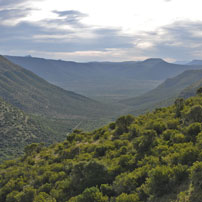 ‘Have you heard about the fight with the “tiger” at Apies Kloof?’ was the question repeatedly asked at the Stock Fair this morning. And indeed the story is one of the most sensational which we have heard for many a long day. It, moreover, has the supreme advantage of being true.’
‘Have you heard about the fight with the “tiger” at Apies Kloof?’ was the question repeatedly asked at the Stock Fair this morning. And indeed the story is one of the most sensational which we have heard for many a long day. It, moreover, has the supreme advantage of being true.’
This extract from the Graaff-Reinet Advertiser on 30th March 1906 tells the tale of an encounter between a “tiger” and a goatherd on the farm, Monkey Valley, that subsequently formed the nucleus of Samara Private Game Reserve in 1997. In those days, the words “tiger” and “wolf” were routinely used to describe that most wily, brave and elusive of big cats, “Napoleon of the veld” – the leopard. The individual in question had been caught by the hind leg in a jackal trap and apprehended by a young goatherd. 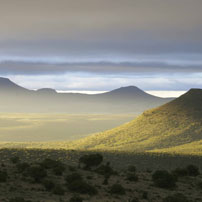 He called in for reinforcements, who attempted to shoot, missed, and set the farm dogs on the enraged beast. All of a sudden the chain of the trap snapped, and the leopard leapt onto the old farm hand who had been wielding the gun. The young herders came to the rescue, tackling and subduing the assailant, until ‘with a mighty roar the animal turned over – and expired.’
He called in for reinforcements, who attempted to shoot, missed, and set the farm dogs on the enraged beast. All of a sudden the chain of the trap snapped, and the leopard leapt onto the old farm hand who had been wielding the gun. The young herders came to the rescue, tackling and subduing the assailant, until ‘with a mighty roar the animal turned over – and expired.’
This story is symptomatic of the persecution of leopards (Panthera pardus) across the Eastern Cape over the past 300 years. Feared by farmers for their deadly hunting effectiveness and prized by hunters for their coats, these big cats have been captured, poisoned and shot to the brink of local extinction. As populations have both declined and fragmented, leopards have sought refuge in only the most isolated and mountainous areas. Samara Private Game Reserve, nestled at the foot of the Sneeuberg mountain range, has long provided ideal habitat for these resilient animals. 18th century 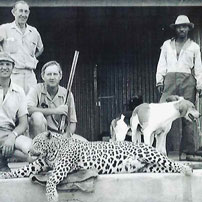 explorers spoke of the abundance of wildlife within the eastern Great Karoo, including lion, cheetah and leopard as well as abundant prey species for these top predators. The Graaff-Reinet Advertiser article even states that the leopard subdued by the young herders was in fact the ninth “tiger” caught at Apies Kloof during the early 1900s.
explorers spoke of the abundance of wildlife within the eastern Great Karoo, including lion, cheetah and leopard as well as abundant prey species for these top predators. The Graaff-Reinet Advertiser article even states that the leopard subdued by the young herders was in fact the ninth “tiger” caught at Apies Kloof during the early 1900s.
Less than 90 years later, however, leopards had been virtually eradicated from the landscape. The last leopard to be shot on what is now Samara land was a female in 1977. She weighed 57kg, more than twice the average female weight of the Cape Leopard found in the Western Cape. Since then, the kloofs and koppies of the Sneeuberg have been for the most part silent. Although it had always been presumed that leopards would thrive in these secluded areas, lack of data and a paucity of sightings suggested that these cats had not yet made Samara their home.
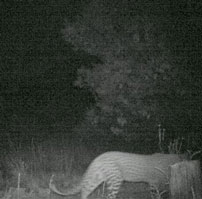 Since 2010, however, leopards in this region appear to be making a comeback. Indications of their presence have slowly accumulated, from occasional spoor sightings to tell-tale scratch marks on tree trunks. During bush dinners in the riverbed, guests have been treated to an unmistakably leopard-like sound – a rasping cough, like sawing through a piece of wood. To the great delight of Samara’s conservation team, in January 2014, a camera trap in the mountains captured the first recorded image of a leopard on the property. In addition, just last month fresh leopard spoor was spotted at the base of Wolwekloof, “Wolf Valley”, by a graduate of the SA College for Tourism Tracker Academy, which is based at Samara. This is particularly exciting news because the latest tracks have been found in
Since 2010, however, leopards in this region appear to be making a comeback. Indications of their presence have slowly accumulated, from occasional spoor sightings to tell-tale scratch marks on tree trunks. During bush dinners in the riverbed, guests have been treated to an unmistakably leopard-like sound – a rasping cough, like sawing through a piece of wood. To the great delight of Samara’s conservation team, in January 2014, a camera trap in the mountains captured the first recorded image of a leopard on the property. In addition, just last month fresh leopard spoor was spotted at the base of Wolwekloof, “Wolf Valley”, by a graduate of the SA College for Tourism Tracker Academy, which is based at Samara. This is particularly exciting news because the latest tracks have been found in 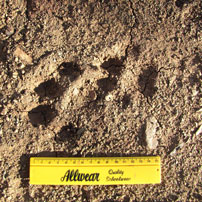 an area close to the lodges and game drive routes. We remain hopeful that these elusive cats will become habituated to human presence so that we may begin to monitor the local populations more effectively.
an area close to the lodges and game drive routes. We remain hopeful that these elusive cats will become habituated to human presence so that we may begin to monitor the local populations more effectively.
This would be of significant scientific interest, given that many questions remain concerning this elusive and much-admired cat, from how it utilises landscapes with a mosaic of different land-uses, to its dietary preferences when prey is sparse. As apex predators in many parts of Africa, including the Great Karoo, leopards have a critical role to play in maintaining healthy ecosystems. However such an endeavour will not be without its challenges. Not only is it difficult to confine leopards within fenced reserves – they have an uncanny ability to escape from any manmade enclosure – but with ranges spanning 500 to 2,000 square kilometres, these solitary beasts could easily disappear into the wilderness once more.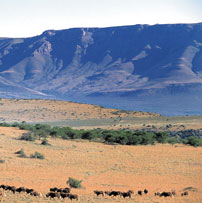
Written by Isabelle Tompkins
Samara is a delightful private reserve located in the dramatic mountains of the Great Karoo near Graaff-Reinet.
